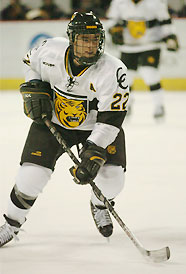Dynasty.
In the world of athletics, this word evokes images of extended brilliance, conjures up memories of rarely seen chemistry and talent, and serves as an inimitable personal reminder of a time of heightened importance gone by.
The teams that realized this ultimate destiny are canonized in sports lore. The Green Bay Packers of the 1960s, UCLA basketball in the ’70s, the Edmonton Oilers of the ’80s, the Chicago Bulls of the ’90s, and the New York Yankees of the last decade all fit this championship mold. Replete with engaging personalities and larger-than-life icons, these teams brought us legendary figures Bart Starr, Kareem Abdul-Jabbar (née Lew Alcindor), Wayne Gretzky, and his Airness, Michael Jordan.
Perhaps, though, it is the Yankees — and their never-been-fiercer rivalry with the Boston Red Sox — that best captures the historically-absurd dominance of today’s Western Collegiate Hockey Association.
At this hegemony, some observers scoff, claiming it an unfortunate trend and bad for college hockey. I disagree.

Like those who assail the Red Sox-Yankees rivalry as bad for baseball, who believe that their absurd payrolls and constant contention — spoken or silent — that they alone are the rightful heirs to the World Series trophy, the naysayers gloss over the fact that baseball’s didactic attracts fans, stirs up unparalleled passion for the sport, pays tribute to its storied history, and — of course — generates immense streams of revenue that ultimately benefit the game.
Ladies and gentlemen: welcome to the WCHA.
For the first time in the 58-year history of the NCAA championship, one conference placed four teams — Colorado College, Minnesota, North Dakota, and now two-time defending champion Denver — in last year’s Frozen Four. Even before this startling achievement, it was evident that the West was, well, best.
Since the national tournament expanded to 16 teams in 2003, the WCHA has placed five teams in the field every year. Even when the bids were limited to just 12 entrants, the WCHA still demonstrated remarkable depth, snagging four slots in 2002 and an unprecedented five — 42 percent of the bids — in 2001.
The WCHA posted a redoubtable 53-17-4 record last season against the other five conferences. Yet by no means are they feasting on the lower tiers — namely nascent College Hockey America or the Atlantic Hockey Association — for against their closest peer, always-tough Hockey East, they compiled a .727 winning percentage. The WCHA put up a 15-5-2 record against the perennial East Coast powers, including Maine, New Hampshire, and the Hub’s finest, BU and BC.
There are also the individual accomplishments. The last four Hobey Baker winners have come from the WCHA, with Colorado College taking home two (Peter Sejna in ’03, Marty Sertich last April), and Minnesota (Jordan Leopold ’02) and Minnesota-Duluth (Junior Lessard ’04) one apiece.
Without the ridiculous unwritten rule that necessitates a winner’s team making the Frozen Four — hopefully obscured by Sejna’s recent victory — the WCHA should have won the award as well in 2000. How Steve Reinprecht, captain of the number-one team in the country and national scoring champion, lost out to mediocre Boston College defenseman Mike Mottau is beyond me.
Putting the emphasis on one game, this one a 4-1 Eagles triumph over Wisconsin in the regional finals, is at worst ignorant of the rigors and unpredictability (read reality) of college hockey, at best short-sighted.
Perhaps it is those same rigors, though, that make the accomplishments of the WCHA in this new century that much more impressive. In addition to sending a disproportionate number of teams each year to the national tournament, the WCHA has done well once it’s gotten there, vying for the championship each of the last six seasons.
Of those six title tilts, they won five (their only loss a 3-2 OT thriller, UND falling to BC in Albany), including the last four. These four consecutive championships are not even the record; also held by the WCHA, that accolade resulted from five titles in a row, bookended by Wisconsin triumphs in ’73 and ’77. That era also saw Minnesota, Michigan Tech, and the Gophers again capture sequential NCAA crowns.
Having already begun their trek toward equaling Michigan’s trifecta of NCAA championships (the Wolverines accomplished the feat from 1951-53), the Denver Pioneers faced a stern and humbling test to their regal headwear, getting swept in Orono by the Black Bears, 5-1 and 4-2. They rebounded nicely back in Colorado, winning at Air Force, 4-2, before downing Notre Dame in Denver, 6-3.
Their rocky road, though, is emblematic of the surprising struggles of the conference thus far this season. To date, league teams have posted a subpar 15-20-2 record against outside challengers, highlighted — if you are not a fan of Minnesota — by those lovable Nanooks from frosty Alaska-Fairbanks taking three of four points in Mariucci Arena.
Although Minnesota fell farther than most, they weren’t alone in their misery. Those who lacked immunity to the upset virus included Minnesota-Duluth and Wisconsin. Upstart Bemidji State went into Duluth and swept away the Bulldogs, 3-2 and 5-1 at the DECC.
At Vermont, the hardly-ferocious canines fared little better, losing consecutive 5-1 decisions, lowering this Frozen Four team of just two seasons ago to 0-4. Those pesky Catamounts must not think the WCHA all that mighty considering that before shooing away the Bulldogs with the broom, they easily dispatched both the Huskies and the host Seawolves in the Land of the Midnight Sun.
Other games of note saw the Badgers split at home with underrated St. Lawrence; after getting shut out by Michigan State, the Sioux swept Northeastern in Grand Forks before finishing an impressive weekend by taking three points at New Hampshire; and highly-skilled Ohio State — currently fourth in the country — split with the third-ranked Tigers.
Despite its outward dominance, within the league there is a constant struggle, and no chance to take nights off, physically or mentally. Home ice is rarely an insurmountable hurdle, and the playoff seeding, invariably in flux, almost always enters the season’s final weekend with no seeds yet firmly planted.
This level of competitiveness stems directly from the extraordinary talent level blossoming within the league. This formidable trend is perfectly encapsulated by the sweepstakes for Phil Kessel, the first Wisconsin native ever to play for the Golden Gophers.
Viewed as a lock to be the first player chosen in next year’s National Hockey League draft, Kessel is an offensive dynamo who prefers the up-and-down, no-holds barred game characteristic of Gopher hockey. Equally important in his selection of schools, though, was the early commitment of longtime teammate and fierce rival Jack Skille, to Wisconsin.
No slouch in his own right, Skille went off the board quickly in this year’s NHL draft, taken by the Chicago Blackhawks seventh overall.
Both world-class players hail from Verona, a suburb of Madison. Quickly becoming a hockey hotbed, Madison is typical of the ever-expanding Midwest talent base. Indeed, nationwide nearly every state has become fertile recruiting land. While not yet on par with the legendary soil in Western Canada, this pullulating is a direct result of the incredible interest in hockey, furthered by the dominance of the WCHA.
For this intraconference parity and inter-league dominance — inexorably linked to the down-in-the-trenches recruiting battles — is reshaping the collegiate landscape. Spurred by record attendance levels (including the postseason, 1,508,427 passed through the turnstiles last year) and state-of-the-art buildings, the college game is becoming more and more popular in faraway and disparate locales. Hence the recent decision to give Frozen Fours to Washington, D.C., Detroit, St. Paul and Tampa from 2009-12.
Thank you, WCHA. Put simply, the conference has promulgated a benevolent circle of hockey: the better the teams, the larger the fan base, the more talented the recruits, and the greater the game.


